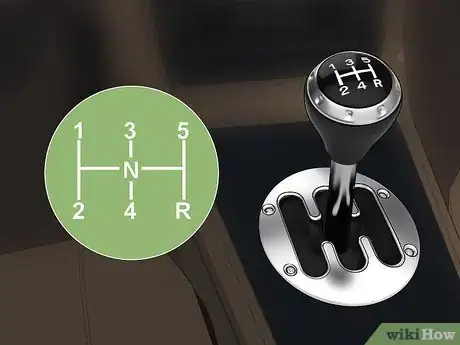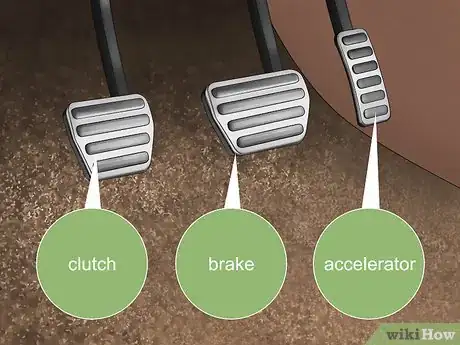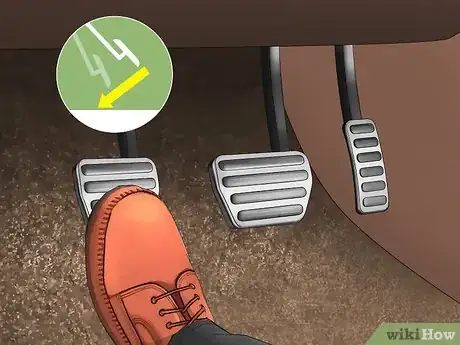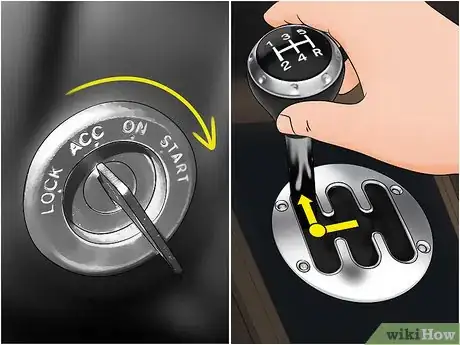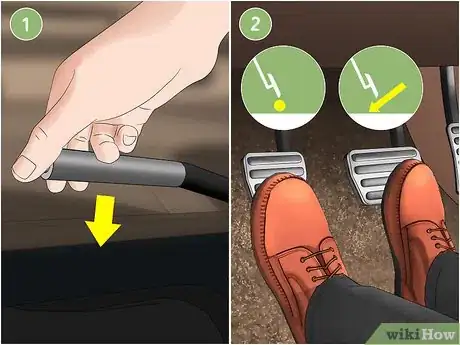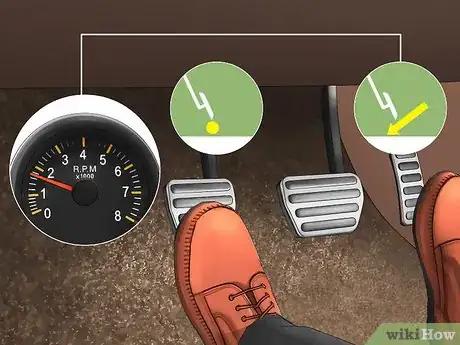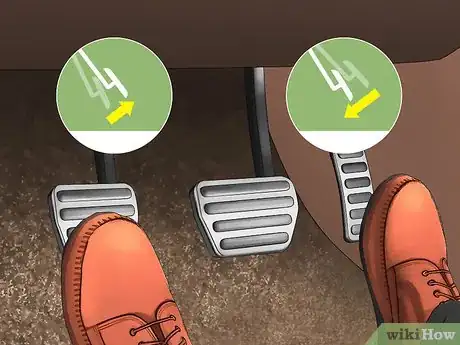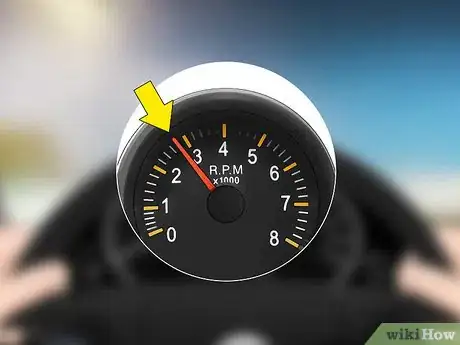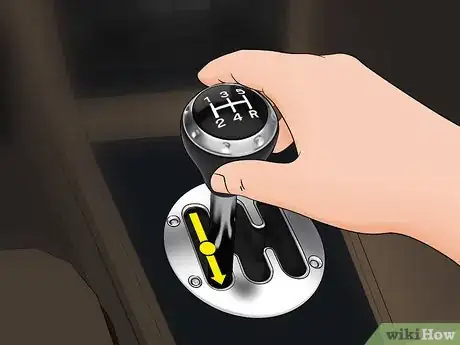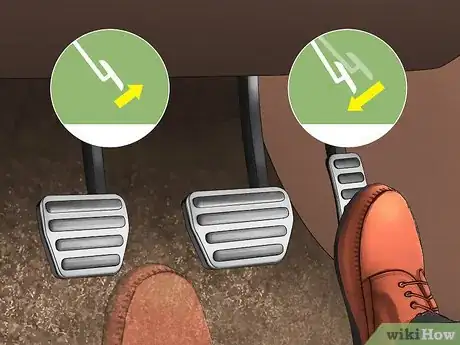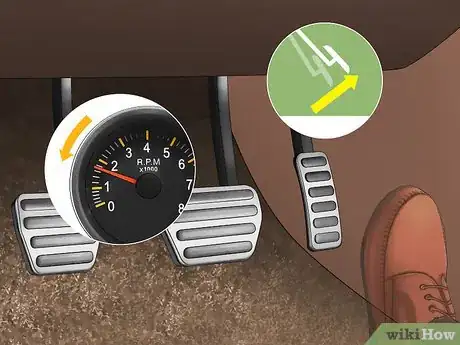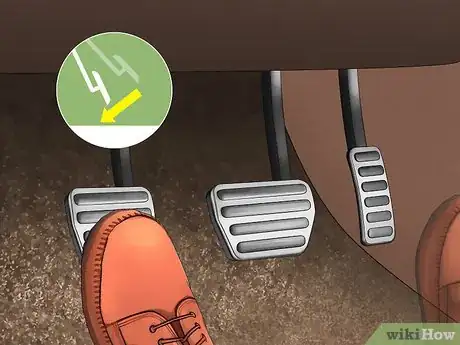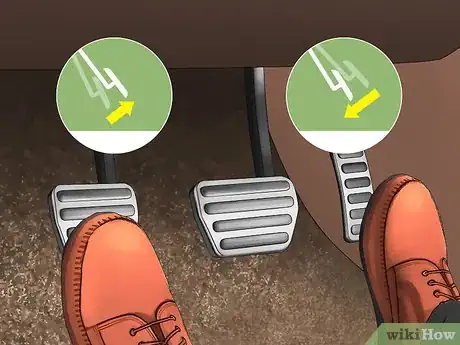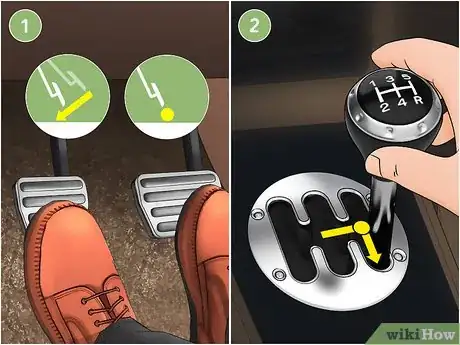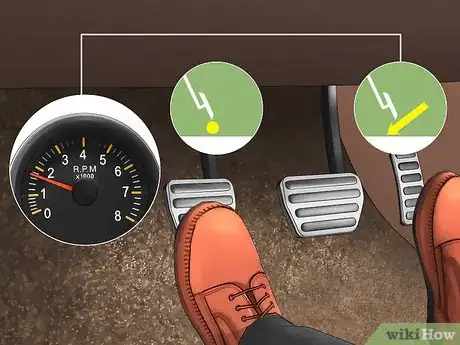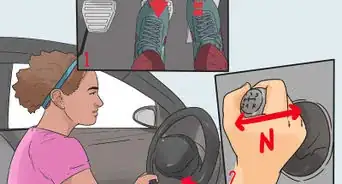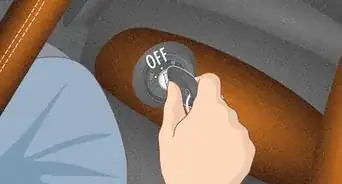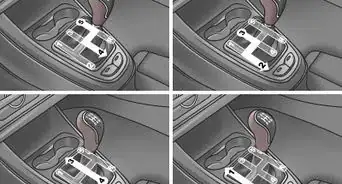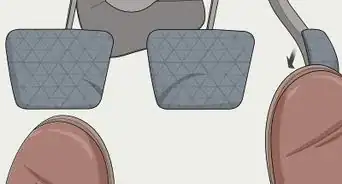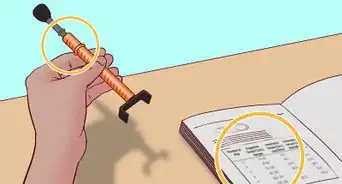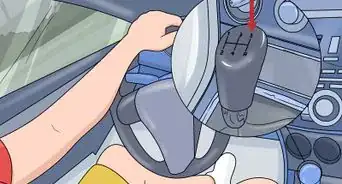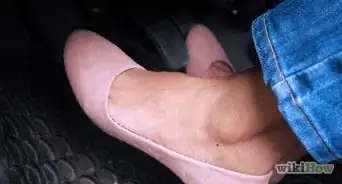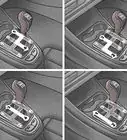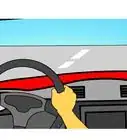This article was co-authored by Ibrahim Onerli and by wikiHow staff writer, Hunter Rising. Ibrahim Onerli is a Driving Instructor and the Manager of Revolution Driving School in New York City. His mission is to make the world a better place by teaching safe driving. Ibrahim trains and manages a team of over eight driving instructors. He specializes in teaching defensive driving and stick shift driving.
There are 13 references cited in this article, which can be found at the bottom of the page.
wikiHow marks an article as reader-approved once it receives enough positive feedback. In this case, 90% of readers who voted found the article helpful, earning it our reader-approved status.
This article has been viewed 108,721 times.
Driving a manual car may seem daunting because of the added pedal and shifter, but you can easily manage the vehicle with a little practice. The clutch and shifter help you shift gears either up or down and are relatively simple to use. Once you familiarize yourself with how they work, you’ll be able to accelerate and decelerate smoothly.
Steps
Familiarizing Yourself with the Gearshift
-
1Memorize the shifting pattern for your car. If you cannot see the pattern physically, check the knob on top of the shifter to see where the gears are located. Many manual transmission cars will be in an H-shaped pattern with the odd-numbered gears on top and the even-numbered gears on bottom.[1]
- For instance, in many cars, first gear is directly above second gear, third gear is to the right of first gear and directly above fourth gear, and fifth gear is to the right of third gear and directly above reverse.
- Neutral position may be indicated with the letter N. Otherwise, your car is in neutral as long as your shifter isn’t in any other gear.
-
2Use your right hand to change gears. Manual transmission cars require you to actively switch between the gears. Keep your right hand on the shifter so you’re prepared to change gears.[2]
- Avoid using your phone or adjusting the radio when you drive a manual transmission. Focus on shifting gears and on the road in front of you.
Advertisement -
3Locate the clutch pedal to the left of the brakes. Use your left foot to locate the pedal on the far left side. Press the clutch down completely whenever you need to shift gears.[3] Avoid holding your foot on the clutch, or else you could wear it down and make it more difficult to shift as your car ages.[4]
Starting the Vehicle
-
1Start in neutral with the parking brake engaged. Since manual transmission cars don’t have a parking gear, the vehicle should already be in neutral with the parking brake on. Check to make sure the shifter is set to neutral and your parking brake is on.[5]
- If the parking brake isn’t engaged, your vehicle will roll.
- Most cars have a light on the dashboard signifying if the parking brake is activated.
-
2Use your left foot to depress the clutch. When you’re ready to start your car, place your left foot on the clutch pedal and press it all the way down.[6]
- Only use your left foot on the clutch pedal so you can control the brakes and gas with your right foot.
-
3Turn the key in the ignition and shift to first gear. Start your car and wait for the engine to roll over. Make sure you keep the clutch depressed with your left foot. Use the shifter on your right side to transition into first gear.[7]
- On a standard 5-speed car, the first gear is located to the left and up on the gear shift. Otherwise, check the top of your shifter to see if it has a guide to where the gears are located.
-
4Release the parking brake and press on the brake pedal. Check your dashboard to make sure the parking brake is fully disengaged. As soon as you release the parking brake, your car will start to roll slightly.[8]
-
5Rev the engine between 1,500-2,000 RPM. Watch the tachometer, the dial that measures your engine rotation speed, so you know when to take your foot off the clutch. You’ll feel a rocking movement on the pedal when the clutch disc tries to catch once your engine hits the right speed.[9]
- If you run at lower RPM, your vehicle will stall and you will have to start your car again.
- When you feel the clutch disc trying to catch, this is known as the “friction point.”
-
6Lift your left foot off of the clutch. Slowly take your foot off the clutch to release the pressure. Your car will start rolling forward. Press the gas pedal down slightly to start accelerating.[10]
Upshifting Your Car
-
1Shift gears when you’re between 2,500-3,000 RPM. Watch the tachometer on your dashboard to see when you reach the right RPM. No matter what gear you’re driving in, plan to shift at the 2,500-3,000 RPM range.[11]
- Avoid shifting gears at a higher or lower RPM since it may cause your car to jerk or stall.
-
2
-
3
-
4Let out the clutch slowly until you feel the friction point. Ease your left foot off of the clutch a little at a time until you feel the clutch disc rocking through the pedal. This point is when your car starts to shift gears.[16]
- You can also look for your RPM to drop on your car’s tachometer to determine when you reach the friction point.
-
5Press down on the accelerator as you ease off the clutch.[17] Imagine each of your feet on the sides of a seesaw. Ease onto the accelerator as you lift off the rest of the clutch. Depress the gas pedal and lift off the clutch at the same speed.[18]
- If you push the gas pedal too fast, the car may jerk and it won’t be a smooth transition between gears.
Downshifting the Vehicle
-
1Take your foot off the accelerator. Lift your foot from the gas pedal so you aren’t accelerating anymore. This will make your RPM slowly decrease so it’s easier to downshift.[19]
-
2Press down on the clutch completely. Use your left foot to fully depress the clutch. Make sure it’s all the way in, or else the shifter won’t work.[20]
-
3Move the gearshift down to the next lowest gear. Only move to the next gear down if you’re driving. For example, if you’re in third gear, use the shifter to move into second gear.[21]
- If you’re coming to a full stop, put the shifter into neutral. You don’t need to feel for the friction point when you’re going into neutral.[22]
-
4Lift your left foot off the clutch slowly while pressing on the gas. Once you’ve shifted gears, you can start taking your foot off the clutch. When you feel the pedal rocking and the clutch disc start to catch, ease back onto the gas pedal to make a smooth transition between gears.[23]
- Watch for when your RPM drop on your car’s tachometer to determine when you reach the friction point.
-
5Engage the parking brake when you park your car. Make sure your car is in neutral when you plan to park it. Lift the parking brake so it’s activated, or else your car will roll when you try to stop it.[24]
- If you leave your car in gear when you turn it off, it will jump forward the next time you try and start it.
Driving in Reverse
-
1Press the brake pedal with your right foot and take off the parking brake. Once you have your foot firmly on the brake, disengage the parking brake with your car in neutral. This will keep your car from moving.[25]
-
2Engage the clutch with your left foot and shift into reverse. Press the clutch down completely, or else you won’t be able to shift gears. Once you have the clutch down, use your gearshift to change from neutral to reverse. Keep your other foot on the brake pedal.[26]
- Check your shifting pattern to find the reverse gear. Common places for reverse are in the bottom right or top left of the pattern.
-
3Rev the engine up to 1,500-2,000 RPM. With your left foot still engaging the clutch, switch your right foot over to the gas pedal and press down slightly. Watch the tachometer on your dashboard to see your engine’s RPM.[27]
-
4Let off the clutch until your car starts moving backward. Ease pressure off of the clutch pedal until you feel the car start to move backward. Once you’re finished driving in reverse, press back down on the clutch and use the brake pedal to stop.[28]
Expert Q&A
Did you know you can get expert answers for this article?
Unlock expert answers by supporting wikiHow
-
QuestionHow do I shift gears in a manual car?
 Ibrahim OnerliIbrahim Onerli is a Driving Instructor and the Manager of Revolution Driving School in New York City. His mission is to make the world a better place by teaching safe driving. Ibrahim trains and manages a team of over eight driving instructors. He specializes in teaching defensive driving and stick shift driving.
Ibrahim OnerliIbrahim Onerli is a Driving Instructor and the Manager of Revolution Driving School in New York City. His mission is to make the world a better place by teaching safe driving. Ibrahim trains and manages a team of over eight driving instructors. He specializes in teaching defensive driving and stick shift driving.
Driving Instructor
-
QuestionHow do I stop a car while in gear 5?
 HelpingHand45Community AnswerStart by hitting the breaks. When you get to a low RPM, make sure the clutch is in so you do not stall the vehicle. Before you take off again, make sure you shifted back down to first gear.
HelpingHand45Community AnswerStart by hitting the breaks. When you get to a low RPM, make sure the clutch is in so you do not stall the vehicle. Before you take off again, make sure you shifted back down to first gear. -
QuestionCan I let off the clutch pedal while in motion for each downshift?
 Community AnswerYes, to let off the clutch you either need to be moving, or be in neutral. When downshifting, the revs may dramatically increase when you let off the clutch, so make sure you slow down enough.
Community AnswerYes, to let off the clutch you either need to be moving, or be in neutral. When downshifting, the revs may dramatically increase when you let off the clutch, so make sure you slow down enough.
Warnings
- Do not skip gears when you shift or else the car may jerk or stall.⧼thumbs_response⧽
References
- ↑ https://www.dmv.org/how-to-guides/driving-stick.php
- ↑ https://driving.ca/auto-news/news/teaching-and-learning-the-art-of-the-manual-gearbox
- ↑ Ibrahim Onerli. Driving Instructor. Expert Interview. 18 November 2019.
- ↑ https://www.dmv.org/how-to-guides/driving-stick.php
- ↑ https://www.dmv.org/how-to-guides/driving-stick.php
- ↑ https://www.dmv.org/how-to-guides/driving-stick.php
- ↑ https://www.dmv.org/how-to-guides/driving-stick.php
- ↑ https://www.dmv.org/how-to-guides/driving-stick.php
- ↑ https://www.dmv.org/how-to-guides/driving-stick.php
- ↑ https://www.dmv.org/how-to-guides/driving-stick.php
- ↑ https://youtu.be/QzIZoZoBPeA?t=19s
- ↑ Ibrahim Onerli. Driving Instructor. Expert Interview. 18 November 2019.
- ↑ https://www.popularmechanics.com/cars/a28461/how-to-drive-stick-manual-transmission/
- ↑ Ibrahim Onerli. Driving Instructor. Expert Interview. 18 November 2019.
- ↑ https://www.popularmechanics.com/cars/a28461/how-to-drive-stick-manual-transmission/
- ↑ https://www.popularmechanics.com/cars/a28461/how-to-drive-stick-manual-transmission/
- ↑ Ibrahim Onerli. Driving Instructor. Expert Interview. 18 November 2019.
- ↑ https://www.popularmechanics.com/cars/a28461/how-to-drive-stick-manual-transmission/
- ↑ https://youtu.be/6W8yiG1yChw?t=1m52s
- ↑ https://youtu.be/6W8yiG1yChw?t=1m55s
- ↑ https://youtu.be/6W8yiG1yChw?t=1m56s
- ↑ https://www.popularmechanics.com/cars/a28461/how-to-drive-stick-manual-transmission/
- ↑ https://youtu.be/6W8yiG1yChw?t=1m58s
- ↑ https://www.popularmechanics.com/cars/a28461/how-to-drive-stick-manual-transmission/
- ↑ https://youtu.be/Ox3gh1S5cEk?t=45s
- ↑ https://youtu.be/Ox3gh1S5cEk?t=58s
- ↑ https://youtu.be/Ox3gh1S5cEk?t=1m11s
- ↑ https://youtu.be/Ox3gh1S5cEk?t=1m33s
About This Article
Driving a manual transmission car can seem a little daunting at first, but once you get used to it, shifting gears will be second nature. Before you practice shifting, make sure you memorize the shifting pattern on the stick. To upshift, you’ll need to accelerate until your engine reaches between 1,500 and 2,000 RPMs. At this point, you’ll hear the engine pitch change and you’ll know it’s time to shift. All you need to do is release the gas pedal and push the clutch fully down to disengage the wheels from the engine. While holding the clutch down, shift your stick into the next gear. Then, slowly release the clutch while easing on with the gas. Downshifting involves the same process as upshifting. The only difference is that you can skip gears when braking heavily. For example, if you slow down for an intersection, you can downshift from 4th to 2nd gear. However, you should never skip gears when upshifting. For more tips, including how to drive in reverse in a manual transmission car, read on!
